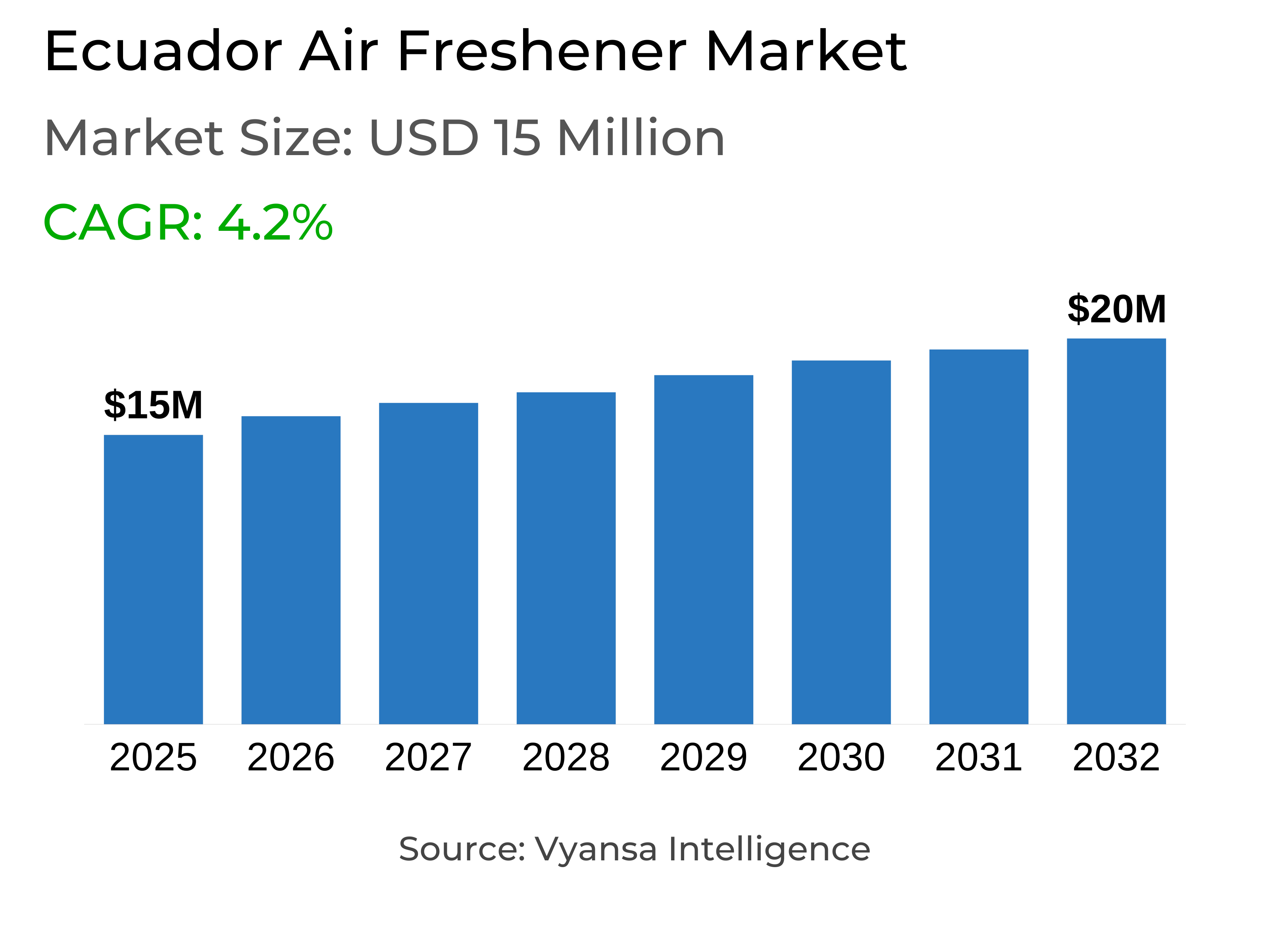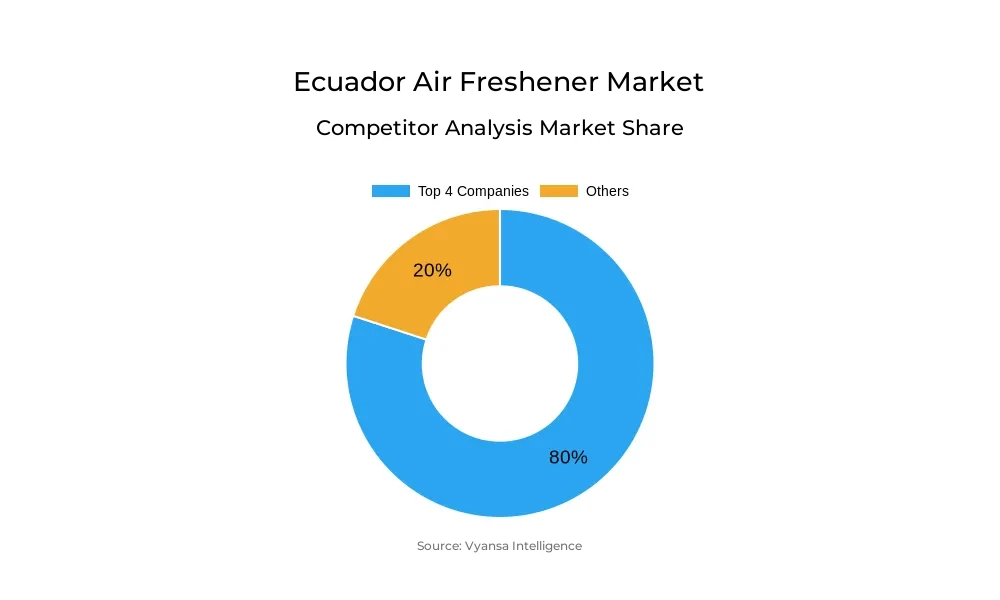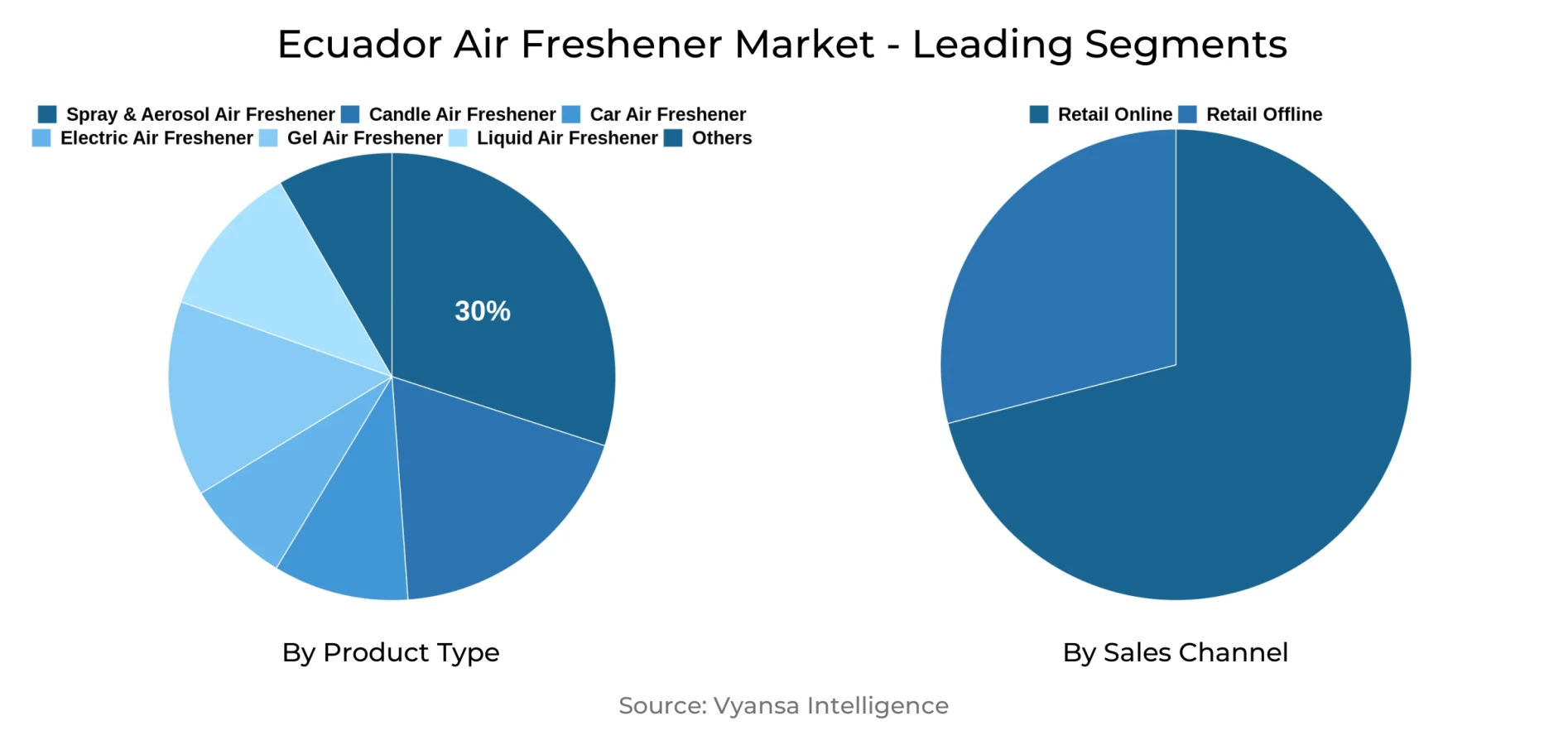Ecuador Air Freshener Market Report: Trends, Growth and Forecast (2026-2032)
By Product Type (Candle Air Freshener, Car Air Freshener, Electric Air Freshener, Gel Air Freshener, Liquid Air Freshener, Spray/Aerosol Air Freshener, Others), By Fragrance (Camomile/Lavender, Lavender, Floral, Vanilla, Lemon, Breeze, Lavender/Vanilla, Cinnamon, Jasmine, Apple/Cinnamon, Rose, Orchid, Mint, Wood), By End User (Consumer, Institutional), By Sales Channel (Retail Online, Retail Offline)
- FMCG
- Dec 2025
- VI0530
- 125
-




Ecuador Air Freshener Market Statistics and Insights, 2026
- Market Size Statistics
- Air Freshener in Ecuador is estimated at $ 15 Million.
- The market size is expected to grow to $ 20 Million by 2032.
- Market to register a CAGR of around 4.2% during 2026-32.
- Product Type Shares
- Spray/Aerosol Air Freshener grabbed market share of 30%.
- Competition
- More than 5 companies are actively engaged in producing Air Freshener in Ecuador.
- Top 4 companies acquired around 80% of the market share.
- Disma SA, Virumec SA, Johnson Wax del Ecuador SA, Calbaq SA etc., are few of the top companies.
- Sales Channel
- Retail Online continues to dominate the market.
Ecuador Air Freshener Market Outlook
The Ecuador air freshener market is still performing well, even during economic hardship. Air care is the highest-performing home care segment, as End users increasingly view air fresheners as an affordable means to enhance home ambiance and wellness. Sprays/aerosols lead in both value and volume based on their affordability, while private label products by retailers like Corporación Favorita consolidate their market presence through brands like Supermaxi, La Original, and Smart. Major players like Glade hold a strong market position by amalgamating potent marketing, regular new product launches, and a wide range of products consisting of sprays, electric air fresheners, and scented candles.
Throughout the forecasting period, electric air fresheners will expand volume growth more rapidly than sprays. Long-term fragrance and convenience make plug-in products appealing, creating opportunities for new entrants to come into the marketplace and promote price competitiveness. Development in this category can be contingent upon overcoming electrical supply issues to maximally exploit its potential.
Retail is the leading channel of sales, with web-based platforms supplementing physical stores. While the majority of End users like purchasing in-store due to variety and instant access, e-commerce enables smaller labels and private labels to find broader audiences, particularly for repeat buys or niche items.
The Ecuador air freshener market is estimated at $15 million and is expected to grow to $20 million by 2032. Continued demand for affordable sprays, expansion of electric air fresheners, innovative scents, and a focus on greener or premium options are likely to drive growth. Increasing End users awareness of home fragrance and wellbeing will further support market expansion.

Ecuador Air Freshener Market Growth Driver
Enhancing Home Ambience Drives Demand
The need for a more comfortable and pleasing living environment remains the driving force behind the air freshener market in Ecuador. End users now view air care products as a convenient means to improve wellbeing and mood at home without needing to break the bank. This emotional connection compels families to spend on products that can brighten up the ambiance and bring about the feeling of comfort, even during economic downturns.
Spray and aerosol air fresheners continue to hold popularity on account of their convenience and affordability, as scented candles and electric air fresheners are sought by those in need of long-lasting fragrance experience. The desire for achieving a warm home environment continues to be a strong driver of purchases and ongoing growth in the air care category.
Ecuador Air Freshener Market Trend
Increased Popularity of Private Label Products
Aerosol and spray private label air fresheners are a key trend in Ecuador's air care market. Retailers are stocking various brands at varying price points, enabling End users to purchase economical alternatives without having to sacrifice on quality. This enhances the availability of air fresheners for a greater number of people and increases overall market penetration.
The trend further underscores increasing End users willingness to try in-house brands that offer diversity in fragrance and packaging. With affordability remaining a driving force in buying decisions, private label items further solidify their position, serving as a mainstay in the changing air freshener market in Ecuador.
Ecuador Air Freshener Market Opportunity
Growth Potential in Electric Air Fresheners
Electric air fresheners are becoming popular as a convenient, long-term replacement for sprays and aerosols. With fewer competitors present at present in this category, there is space for new companies to launch innovative products and price them more competently for End users. This is an opportunity to grow the market and address increasing demand for new, simple-to-use solutions.
Plug-in air fresheners provide constant fragrance and improve overall home ambiance, which finds favor among End users looking for convenience and prolonged scent. Overcoming infrastructure hurdles, i.e., reliable electrical power supply, can further release growth potential and enable this segment to enjoy a greater share of the air care market.
Ecuador Air Freshener Market Segmentation Analysis

By Product Type
- Candle Air Freshener
- Car Air Freshener
- Electric Air Freshener
- Gel Air Freshener
- Liquid Air Freshener
- Spray/Aerosol Air Freshener
- Others
The segment with highest market share under Product Type is held by Spray/Aerosol Air Freshener, which took a market share of 30%. This segment remains at the forefront of the market through its competitiveness and availability. Spray/aerosols are in demand among End users for the convenience and affordability that it provides in improving home ambiance. Private labels have also enhanced this segment with competitive pricing and multi-packs, making these products available to a wider End users base. Major players such as Glade sustain their leadership by incessantly launching new fragrances, various formats, and aggressive advertising that emphasizes the emotional value of fragrance.
Under Product Type, Electric Air Fresheners are growing as a high-growth category. While less competitive today, this category provides sustained fragrance and ease of use, appealing to End users who seek premium experience. Growing adoption and penetration by more price-conscious brands is anticipated to further drive sales, making electric air fresheners a primary driver of future growth in the market.
By Sales Channel
- Retail Online
- Retail Offline
The segment with highest market share under sales channel is retail offline. Supermarkets, convenience stores, and specialty retail stores provide End users with easy access to buy air fresheners. The majority of Ecuadorian End users depend on these offline stores for air fresheners due to the ease and variety they provide. Offline retail remains to be the source of most of the sales volume in the nation based on a survey.
Meanwhile, online retail is growing quickly and remains in control of the market within the cyber world. Increasing numbers of End users are making use of e-commerce websites for air freshener buys, attracted to internet bargains and in-home delivery. Online retailing does well with young, urban End users, and its proportion is forecast to continue rising over the next several years, underpinning ongoing market development according to a poll
Top Companies in Ecuador Air Freshener Market
The top companies operating in the market include Disma SA, Virumec SA, Johnson Wax del Ecuador SA, Calbaq SA, etc., are the top players operating in the Ecuador Air Freshener Market.
Frequently Asked Questions
Related Report
1. Market Segmentation
1.1. Research Scope
1.2. Research Methodology
1.3. Definitions and Assumptions
2. Executive Summary
3. Ecuador Air Freshener Market Policies, Regulations, and Standards
4. Ecuador Air Freshener Market Dynamics
4.1. Growth Factors
4.2. Challenges
4.3. Trends
4.4. Opportunities
5. Ecuador Air Freshener Market Statistics, 2022-2032F
5.1. Market Size & Growth Outlook
5.1.1. By Revenues in US$ Million
5.2. Market Segmentation & Growth Outlook
5.2.1. By Product Type
5.2.1.1. Candle Air Freshener- Market Insights and Forecast 2022-2032, USD Million
5.2.1.2. Car Air Freshener- Market Insights and Forecast 2022-2032, USD Million
5.2.1.3. Electric Air Freshener- Market Insights and Forecast 2022-2032, USD Million
5.2.1.4. Gel Air Freshener- Market Insights and Forecast 2022-2032, USD Million
5.2.1.5. Liquid Air Freshener- Market Insights and Forecast 2022-2032, USD Million
5.2.1.6. Spray/Aerosol Air Freshener- Market Insights and Forecast 2022-2032, USD Million
5.2.1.7. Others- Market Insights and Forecast 2022-2032, USD Million
5.2.2. By Fragrance
5.2.2.1. Camomile/Lavender- Market Insights and Forecast 2022-2032, USD Million
5.2.2.2. Lavender- Market Insights and Forecast 2022-2032, USD Million
5.2.2.3. Floral- Market Insights and Forecast 2022-2032, USD Million
5.2.2.4. Vanilla- Market Insights and Forecast 2022-2032, USD Million
5.2.2.5. Lemon- Market Insights and Forecast 2022-2032, USD Million
5.2.2.6. Breeze- Market Insights and Forecast 2022-2032, USD Million
5.2.2.7. Lavender/Vanilla- Market Insights and Forecast 2022-2032, USD Million
5.2.2.8. Cinnamon- Market Insights and Forecast 2022-2032, USD Million
5.2.2.9. Jasmine- Market Insights and Forecast 2022-2032, USD Million
5.2.2.10. Apple/Cinnamon- Market Insights and Forecast 2022-2032, USD Million
5.2.2.11. Rose- Market Insights and Forecast 2022-2032, USD Million
5.2.2.12. Orchid- Market Insights and Forecast 2022-2032, USD Million
5.2.2.13. Mint- Market Insights and Forecast 2022-2032, USD Million
5.2.2.14. Wood- Market Insights and Forecast 2022-2032, USD Million
5.2.3. By End User
5.2.3.1. Consumer- Market Insights and Forecast 2022-2032, USD Million
5.2.3.2. Institutional- Market Insights and Forecast 2022-2032, USD Million
5.2.4. By Sales Channel
5.2.4.1. Retail Online- Market Insights and Forecast 2022-2032, USD Million
5.2.4.2. Retail Offline- Market Insights and Forecast 2022-2032, USD Million
5.2.5. By Competitors
5.2.5.1. Competition Characteristics
5.2.5.2. Market Share & Analysis
6. Ecuador Candle Air Freshener Market Statistics, 2022-2032F
6.1. Market Size & Growth Outlook
6.1.1. By Revenues in US$ Million
6.2. Market Segmentation & Growth Outlook
6.2.1. By Fragrance- Market Insights and Forecast 2022-2032, USD Million
6.2.2. By End User- Market Insights and Forecast 2022-2032, USD Million
6.2.3. By Sales Channel- Market Insights and Forecast 2022-2032, USD Million
7. Ecuador Car Air Freshener Market Statistics, 2022-2032F
7.1. Market Size & Growth Outlook
7.1.1. By Revenues in US$ Million
7.2. Market Segmentation & Growth Outlook
7.2.1. By Fragrance- Market Insights and Forecast 2022-2032, USD Million
7.2.2. By End User- Market Insights and Forecast 2022-2032, USD Million
7.2.3. By Sales Channel- Market Insights and Forecast 2022-2032, USD Million
8. Ecuador Electric Air Freshener Market Statistics, 2022-2032F
8.1. Market Size & Growth Outlook
8.1.1. By Revenues in US$ Million
8.2. Market Segmentation & Growth Outlook
8.2.1. By Fragrance- Market Insights and Forecast 2022-2032, USD Million
8.2.2. By End User- Market Insights and Forecast 2022-2032, USD Million
8.2.3. By Sales Channel- Market Insights and Forecast 2022-2032, USD Million
9. Ecuador Gel Air Freshener Market Statistics, 2022-2032F
9.1. Market Size & Growth Outlook
9.1.1. By Revenues in US$ Million
9.2. Market Segmentation & Growth Outlook
9.2.1. By Fragrance- Market Insights and Forecast 2022-2032, USD Million
9.2.2. By End User- Market Insights and Forecast 2022-2032, USD Million
9.2.3. By Sales Channel- Market Insights and Forecast 2022-2032, USD Million
10. Ecuador Liquid Air Freshener Market Statistics, 2022-2032F
10.1. Market Size & Growth Outlook
10.1.1. By Revenues in US$ Million
10.2. Market Segmentation & Growth Outlook
10.2.1. By Fragrance- Market Insights and Forecast 2022-2032, USD Million
10.2.2. By End User- Market Insights and Forecast 2022-2032, USD Million
10.2.3. By Sales Channel- Market Insights and Forecast 2022-2032, USD Million
11. Ecuador Spray/Aerosol Air Freshener Market Statistics, 2022-2032F
11.1. Market Size & Growth Outlook
11.1.1. By Revenues in US$ Million
11.2. Market Segmentation & Growth Outlook
11.2.1. By Fragrance- Market Insights and Forecast 2022-2032, USD Million
11.2.2. By End User- Market Insights and Forecast 2022-2032, USD Million
11.2.3. By Sales Channel- Market Insights and Forecast 2022-2032, USD Million
12. Competitive Outlook
12.1. Company Profiles
12.1.1. Johnson Wax del Ecuador SA
12.1.1.1. Business Description
12.1.1.2. Product Portfolio
12.1.1.3. Collaborations & Alliances
12.1.1.4. Recent Developments
12.1.1.5. Financial Details
12.1.1.6. Others
12.1.2. Calbaq SA
12.1.2.1. Business Description
12.1.2.2. Product Portfolio
12.1.2.3. Collaborations & Alliances
12.1.2.4. Recent Developments
12.1.2.5. Financial Details
12.1.2.6. Others
12.1.3. Disma SA
12.1.3.1. Business Description
12.1.3.2. Product Portfolio
12.1.3.3. Collaborations & Alliances
12.1.3.4. Recent Developments
12.1.3.5. Financial Details
12.1.3.6. Others
12.1.4. Virumec SA
12.1.4.1. Business Description
12.1.4.2. Product Portfolio
12.1.4.3. Collaborations & Alliances
12.1.4.4. Recent Developments
12.1.4.5. Financial Details
12.1.4.6. Others
13. Disclaimer
| Segment | Sub-Segment |
|---|---|
| By Product Type |
|
| By Fragrance |
|
| By End User |
|
| By Sales Channel |
|
Research Methodology
This study followed a structured approach comprising four key phases to assess the size and scope of the electro-oxidation market. The process began with thorough secondary research to collect data on the target market, related markets, and broader industry context. These findings, along with preliminary assumptions and estimates, were then validated through extensive primary research involving industry experts from across the value chain. To calculate the overall market size, both top-down and bottom-up methodologies were employed. Finally, market segmentation and data triangulation techniques were applied to refine and validate segment-level estimations.
Secondary Research
The secondary research phase involved gathering data from a wide range of credible and published sources. This step helped in identifying industry trends, defining market segmentation, and understanding the market landscape and value chain.
Sources consulted during this phase included:
- Company annual reports, investor presentations, and press releases
- Industry white papers and certified publications
- Trade directories and market-recognized databases
- Articles from authoritative authors and reputable journals
- Gold and silver standard websites
Secondary research was critical in mapping out the industry's value chain and monetary flow, identifying key market segments, understanding regional variations, and tracking significant industry developments.
Other key sources:
- Financial disclosures
- Industry associations and trade bodies
- News outlets and business magazines
- Academic journals and research studies
- Paid industry databases
Primary Research
To validate secondary data and gain deeper market insights, primary research was conducted with key stakeholders across both the supply and demand sides of the market.
On the demand side, participants included decision-makers and influencers from end-user industries—such as CIOs, CTOs, and CSOs—who provided first-hand perspectives on market needs, product usage, and future expectations.
On the supply side, interviews were conducted with manufacturers, industry associations, and institutional participants to gather insights into current offerings, product pipelines, and market challenges.
Primary interviews provided critical inputs such as:
- Market size and revenue data
- Product and service breakdowns
- Market forecasts
- Regional and application-specific trends
Stakeholders consulted included:
- Leading OEM and solution providers
- Channel and distribution partners
- End users across various applications
- Independent consultants and industry specialists
Market Size Estimation and Data Triangulation
- Identifying Key Market Participants (Secondary Research)
- Goal: To identify the major players or companies in the target market. This typically involves using publicly available data sources such as industry reports, market research publications, and financial statements of companies.
- Tools: Reports from firms like Gartner, Forrester, Euromonitor, Statista, IBISWorld, and others. Public financial statements, news articles, and press releases from top market players.
- Extracting Earnings of Key Market Participants
- Goal: To estimate the earnings generated from the product or service being analyzed. This step helps in understanding the revenue potential of each market player in a specific geography.
- Methods: Earnings data can be gathered from:
- Publicly available financial reports (for listed companies).
- Interviews and primary data sources from professionals, such as Directors, VPs, SVPs, etc. This is especially useful for understanding more nuanced, internal data that isn't publicly disclosed.
- Annual reports and investor presentations of key players.
- Data Collation and Development of a Relevant Data Model
- Goal: To collate inputs from both primary and secondary sources into a structured, data-driven model for market estimation. This model will incorporate key market KPIs and any independent variables relevant to the market.
- Key KPIs: These could include:
- Market size, growth rate, and demand drivers.
- Industry-specific metrics like market share, average revenue per customer (ARPC), or average deal size.
- External variables, such as economic growth rates, inflation rates, or commodity prices, that could affect the market.
- Data Modeling: Based on this data, the market forecasts are developed for the next 5 years. A combination of trend analysis, scenario modeling, and statistical regression might be used to generate projections.
- Scenario Analysis
- Goal: To test different assumptions and validate how sensitive the market is to changes in key variables (e.g., market demand, regulatory changes, technological disruptions).
- Types of Scenarios:
- Base Case: Based on current assumptions and historical data.
- Best-Case Scenario: Assuming favorable market conditions, regulatory environments, and technological advancements.
- Worst-Case Scenario: Accounting for adverse factors, such as economic downturns, stricter regulations, or unexpected disruptions.
Partnering With Industry Leaders to Drive Growth
Our mission is to deliver intelligence that matters. By combining data, analysis, and industry expertise, we enable organizations to make smarter, faster, and more impactful decisions. Whether it’s a Fortune 500 company or a high-growth startup, businesses trust us to provide clarity in an ever-evolving marketplace.






